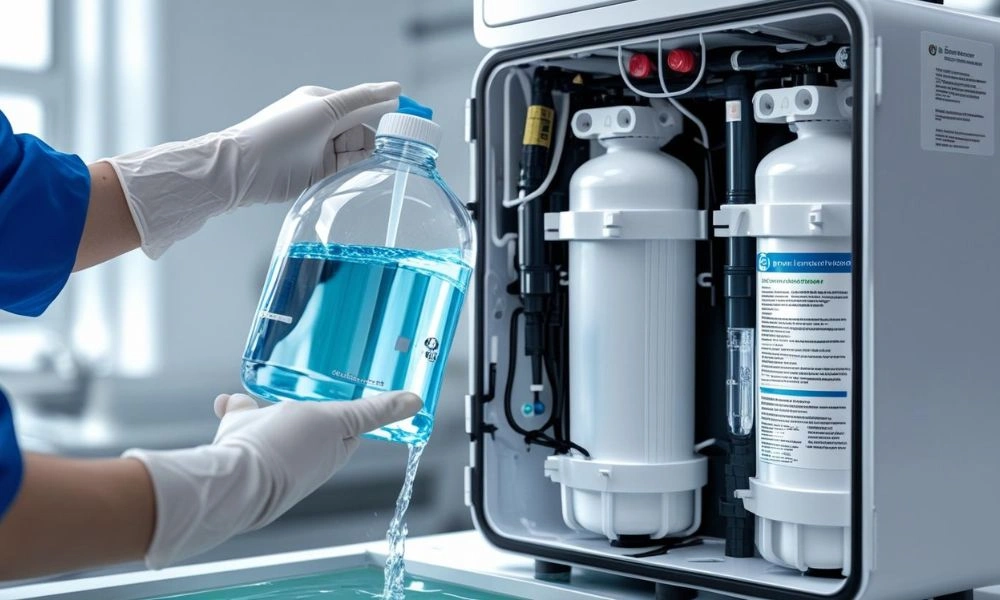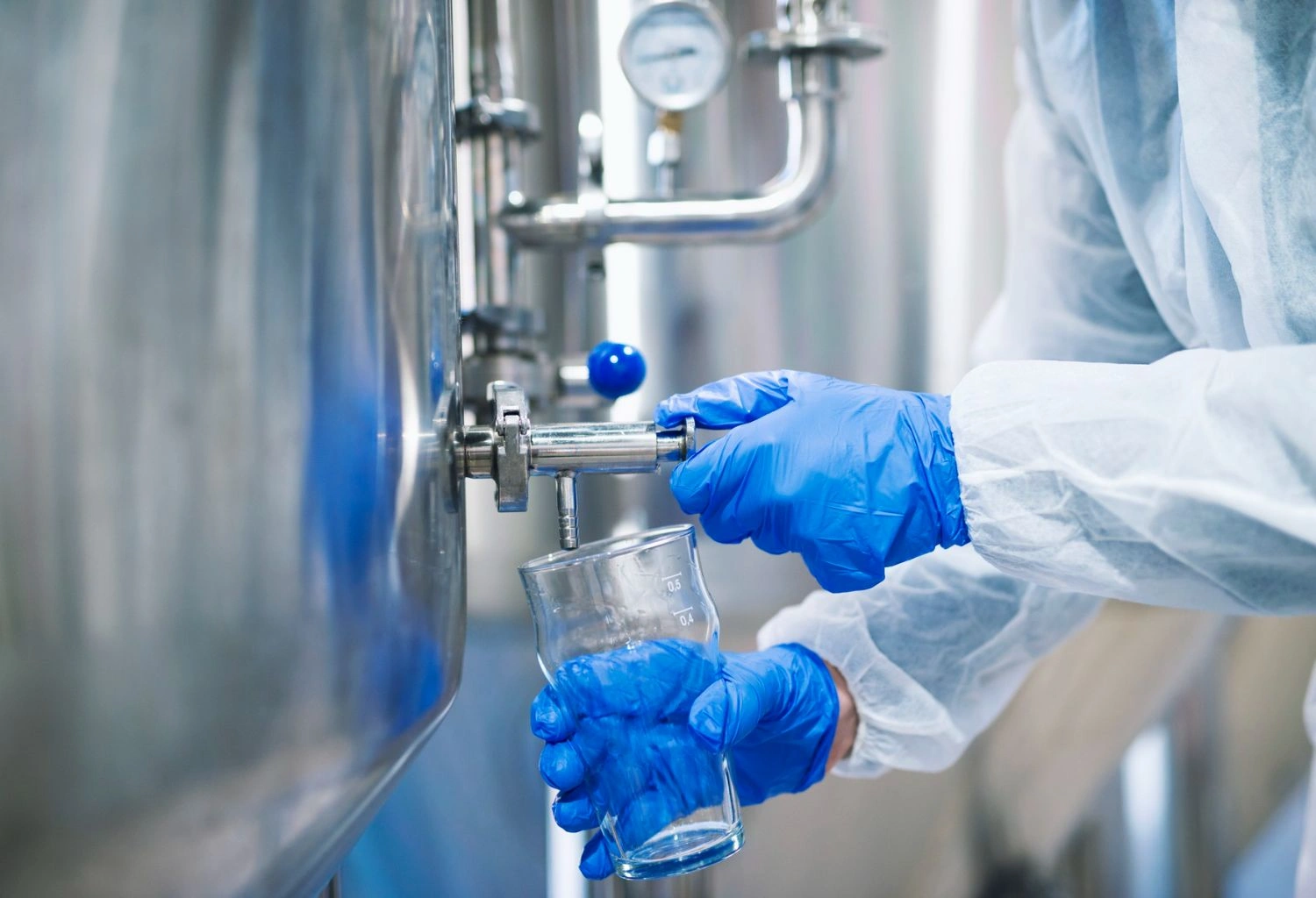Sterilize your RO water filtration system ensures safe, odor-free, and healthy drinking water. With expert tips from WCSP, you can follow a simple process using safe agents like bleach or hydrogen peroxide. Regular cleaning improves water taste, extends filter life, and maintains the system’s performance for years to come.
Ultra-filtration Water Plant
Why Sterilize Your RO Water Filtration System Is Necessary?
Your RO system does more than purify water—it makes your drinking water free from unseen contaminants such as bacteria, mold, and viruses. Even high-quality systems such as those provided by WCSP can harbor microbial buildup over time. Without sterilization, clean water can become re-contaminated within your system.This is particularly crucial in Pakistan, where water purity differs from place to place. Be it in an industrial compound or residential complex, sterilizing your RO system ensures the water not just filtered—but absolutely clean.
How Often Should You Sterilize Your System?
For typical homes or small businesses, once every 6 to 12 months would suffice. However, there are certain occasions when sterilization becomes imperative:
- After replacing filters
- If the unit remained idle for weeks or months
- When relocating the system to a new place
- After an occurrence of plumbing trouble or contamination
- If there’s any unusual taste or odor in your water
A regular cleaning process ensures the RO system runs optimally for years.
What to Do Before You Start Cleaning?
Before you start, always turn off the water supply and power. Turn on the RO faucet and let the water drain out of the storage tank. Then, take out all the filters—the RO membrane, pre-filters, and post-filters. This is an important step: never clean the system with the filters in place.
Get Ready With These Items:
A small quantity of unscented bleach or food-grade hydrogen peroxide
- A clean mixing container
- Rubber gloves
- Clean water to flush afterwards
Avoid using scented cleaners, vinegar, boiling water, or soap-based cleaners—these could harm internal components or cause residue to be left behind.
Containerized/Packaged Type Systems
Step-by-Step Guide to Sterilize Your RO System
This will work in most under-sink or compact commercial RO systems:
- Place your cleaning solution into one of the unused pre-filter housings. A mere 1–2 tablespoons of plain bleach or 10–15 mL hydrogen peroxide should suffice.
- Reconnect the system without filters. Reattach the housings and restore the feed water.
- Allow the system to fill up full. Water will combine with the cleaning solution and travel through pipes and tank.
- Wait 30–60 minutes. This gives the solution time to sanitize all internal surfaces.
- Drain the system completely by opening the RO faucet. Fill and flush the system with clean water at least two times.
- Reinstall all filters after flushing. Then let the system run and store new water.
Benefits of Regular RO Sterilization
A clean RO system doesn’t just taste better—it lasts longer and protects your health. Here are some benefits:
- Prevents bacteria and mold buildup
- Keeps your water odor-free and fresh
- Increases the life of your RO membrane
- Avoids system clogs and pressure issues
- Maintains filter performance and water flow
For healthcare facilities or industries, the stakes are even greater. Clean water is essential for safety and regulation compliance.
Mistakes to Avoid
Even the simplest steps can be botched if hurried. Don’t make these errors:
- Don’t mix bleach with filters in place
- Don’t forget to flush thoroughly once you’ve sterilized
- Don’t use an excess of cleaning agent—more isn’t better
- Don’t neglect regular cleaning simply because water “looks fine”
With careful procedure, you prevent damage and make your water safe.
How WCSP Facilitates Sterilization and Maintenance?
Water Care Services Pakistan (WCSP) is a top-tier ISO-certified organization with extensive experience in water purification. Their equipment is designed for long-term operation and simple maintenance. But most importantly, they instruct users when and how to clean, maintain, and upgrade their equipment.If you don’t know how to clean your system—or you want full maintenance—WCSP technicians can do it safely. Be it a household unit or an industrial-scale RO plant, proper cleaning is their comprehensive water management plan.
Conclusion
Sterilizing your RO system is more than maintenance—it’s a necessity for your health and your system’s functionality. With safe solutions such as hydrogen peroxide or bleach, and the proper procedures, you can decontaminate bacteria, prolong filter life, and ensure your water stays fresh tasting. Whether home unit or industrial facility, cleaning is simple and essential. And should you ever have a question, WCSP is always available to provide expert service and professional guidance.
Frequently Asked Questions (FAQs)
1. Why is sterilizing an RO system necessary?
Sterilization removes bacteria, mold, and viruses that can build up over time, ensuring your filtered water stays clean and safe to drink.
2. How often should I sterilize my RO system?
Typically, every 6 to 12 months. However, you should also sterilize it after filter changes, long idle periods, relocation, or any plumbing issues.
3. What signs indicate my RO system needs sterilization?
Unusual taste, foul odors, reduced flow, or visible residue inside components are strong indicators that cleaning is needed.
4. Can I use vinegar or soap to sterilize my RO system?
No. Avoid using vinegar, soap, or scented cleaners—they may damage internal parts or leave harmful residues. Use unscented bleach or food-grade hydrogen peroxide only.
5. Should filters be removed before sterilizing?
Yes, always remove all filters and membranes before sterilizing. Cleaning with them installed can damage the filters and contaminate the system.
6. How much bleach or hydrogen peroxide should I use?
Use 1–2 tablespoons of unscented bleach or 10–15 mL of food-grade hydrogen peroxide, diluted in clean water, depending on system size.
7. What’s the recommended sterilization procedure?
Introduce the solution into the housing, fill the system, let it sit for 30–60 minutes, then flush thoroughly twice with clean water before reinstalling filters.
8. Can improper sterilization damage my RO system?
Yes. Overuse of chemicals, failure to flush properly, or cleaning with filters installed can cause permanent damage or contamination.
9. Is sterilization different for residential and industrial RO systems?
The basic concept is the same, but industrial systems may require more advanced methods or professional servicing, especially for regulatory compliance.
10. Can WCSP help with RO system sterilization?
Absolutely. WCSP offers expert maintenance and sterilization services for both home and industrial RO systems, ensuring optimal performance and hygiene.



